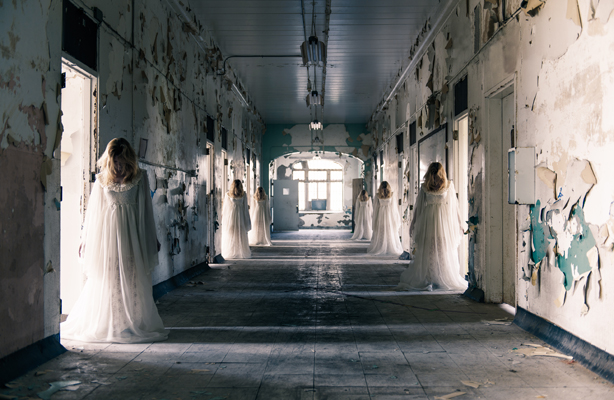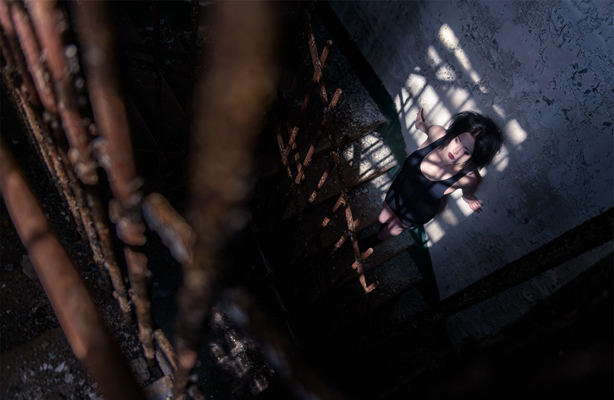by Scott Detweiler, Texas School Instructor
Most photographers probably dream of working on location in incredible places where one might enounter the occasional giraffe or perhaps a dolphin. However, a few years ago, I was exposed to the dark side after being invited by my good friend, Brett, to visit and shoot inside a vast, abandoned insane asylum erected before the Civil War. Since that experience, I have the urge to visit destinations where one is more likely to get Tetanus than to see a family of elk.
There is a strange allure to working on location in these abandoned buildings. Part of that is the architecture and history of the building, especially the more fantastic edifices but, secretly, I think I am just in it for the spooky factor with my mind pondering the 100,000 people who died in that asylum in West Virginia. It makes one look at the extensive doctor’s lavoratory with a different mind-set. This massive, sink adorned room, is where doctors would start their days, wash-up between operations, and chat with other physicians about patients. When I walk through the halls of places like this, my mind wanders to the history. However, I also ponder the architectural workmanship that surely held a sense of accomplishment for the artisan. But now they are probably long dead and forgotten.
 In the solitary confinement room, the name of a nurse who would torment patients for over 30 years, is carved into the concrete floor. That gives one a feeling that can’t be explained. Could this be one of those things that is measured by gizmos adorned with a lot of blinking lights on those ghost hunter shows?
In the solitary confinement room, the name of a nurse who would torment patients for over 30 years, is carved into the concrete floor. That gives one a feeling that can’t be explained. Could this be one of those things that is measured by gizmos adorned with a lot of blinking lights on those ghost hunter shows?
What is the allure of these broken buildings? Truthfully, I can’t be sure what attracts me to them. Most of the subject matter I do enjoy shooting falls into two distinct categories, those that complement the place, and those that oppose it. For example, shooting high-fashion and artistic nudes argues with the destruction all around the subject, and that dichotomy is interesting to me. The other category embraces the nature of the place, and there is where I get into my arcane mood and work on somewhat disturbing images that evoke an emotion. I am not one who is into gore or blood but I enjoy the more subtle ways of giving those little hairs on the back of the neck a workout. Creating spooky images and seeing the proper response is more natural than some other forms of art where pretentious people come up with all the sorts of wild reasons why you made an artistic choice. In this case, they just drop their glass of wine and freak out, and you know your mission is accomplished.

I embrace the feeling you get from a specific location. Most of the time, this isn’t going to be a happy one and we might as well go ahead and call it creepy. As you can probably guess, I love creating images filled with emotion in places like these. Most of mine also include a figure, which might be wearing something that fits the theme, or a beautiful nude. Another common reason for risking entry into these abandoned locations is the sheer wealth of goodies for compositing. Unique textures and scenes can be found that just don’t come along frequently and capturing them adds a different character to my images.
 Another question probably on your mind is, “Do you believe in ghosts?” The answer is “no,” and I have been in many places that should be on ghost’s introductory booklet of “places to haunt.”
Another question probably on your mind is, “Do you believe in ghosts?” The answer is “no,” and I have been in many places that should be on ghost’s introductory booklet of “places to haunt.”
Now that you know the reasons I enjoy it, you are probably ready to grab your camera and find some busted house for your next photo session. Before you do that and end up in jail or worse, let’s talk about some of the things you need to know before you venture forth. Keep in mind this isn’t an exhaustive list, and I am not an expert like some hard-core “urbex” photographers. However, this is information that I’ve found to be helpful and some golden rules to pass on to the worthy adventurer:
Don’t go into basements. There are structural concerns in most of these places, and being on the bottom of the pile doesn’t have the best odds of survivability. Secondly, if there are ne’er-do-wells, wild animals, crazy spiders, and exploding fungus, this is where they prefer to live. Bring a sword and a torch or two if you plan to venture down those stairs alone because I am not coming with you.

The opposite of the basement is the roof. Often the weakest part of the structure for load bearing, walking on one of these is a more significant dice roll than the band of stupid adventurers that went into the basement.
Don’t go into houses. Houses are where people are likely to be living (duh). Even after the original residents have moved on, many without a home will be happy to claim a new one, and they don’t much care for visitors. Unless you are an aspiring crack dealer or have a death wish, just stay out of houses. They also offer some of the weakest floors and decay much more quickly than their commercial counterparts.
 One of the phrases I have heard uttered is, “Breaking and entering is a felony, but trespassing is a misdemeanor.” Now, I am not condoning you enter places you legally should not be, but keep in mind that you are probably breaking a law or two in most cases. Be especially careful of federal properties, like abandoned post offices, as those places are felonies even if the front door is wide open or perhaps even missing.
One of the phrases I have heard uttered is, “Breaking and entering is a felony, but trespassing is a misdemeanor.” Now, I am not condoning you enter places you legally should not be, but keep in mind that you are probably breaking a law or two in most cases. Be especially careful of federal properties, like abandoned post offices, as those places are felonies even if the front door is wide open or perhaps even missing.
There are plenty of abandoned buildings where you can enter for a small fee and enjoy a day of photography without fear of being hauled away in handcuffs or face a hefty fine. Often contacting a cities Film & Television office to ask about an Urban Explorer pass or permit will get you a list of locations and a gauge on the relative safety of those spots as well. Just because you have permission doesn’t necessarily mean you are safe from those willing to do you harm and take your camera gear so they can start selling a DVD of high-school senior portraits for $5. Use common sense and don’t go alone.
Wear proper clothing, as many of these places are downright dangerous. Wearing safety shoes is a must! They keep you from stepping on thousands of evil looking nails, that strategically hidden pile of poo, and other scary things you probably should kick before they bite you. Also, be sure to change your shoes after you leave the building. No one wants to track whatever you stepped in all over your house or the inside of your car.
Don’t do damage! Even if you are in a place that is so rampant with graffiti you would be challenged to write your initials; you are there to explore and document, not to alter the location. On top of that, every time you move something you stir up dust that can contain a lot of things you probably don’t want to breathe into your lungs. Having said that, consider wearing a mask. Fungal spores, rampant mold, and, of course, the decidedly fine lung-shredding particles of asbestos are often prevalent. Depending on your research and knowledge of the location, any or all of these safety precautions are things one should consider. As I have said before, use common sense.
Many of the most exciting places are those off the beaten path. Most cities have buildings that might still have the original furnishings, equipment, or be in pristine but an aged condition. These are gold mines and are closely guarded secrets with those that discover them. Often a little research can often open a door (literally), that would not otherwise be available. Having a robust portfolio of work can also talk you into locations where they know you will have respect for their property. That same portfolio can often get you out of a situation with the law when they can see your work and know you are not the type of person that they should be concerned about arresting. Of course, all of this goes out the window if you happen to be in a place you shouldn’t be, and the owner of the property wants to wreck your life and sue you to set an example.
Please keep all of these things in mind and have a plan, do your research, and work quickly. The less gear you can take with you, the better off you will be. Best of luck, and please use common sense if you choose to follow this path, worthy adventurer.
 Scott Detweiler, from Sussex, Wisconsin, will be one of the instructors for Texas School 2020. In his class, Scott will cover his approach to lighting as well as how to reverse engineer light you see in images you love. Using this information, students will delve into his approach to photography, mixing natural and artificial light, working with advanced composition, and post-production that will make their work stand out from the crowd. For more about Scott, go to www.sedetweiler.com.
Scott Detweiler, from Sussex, Wisconsin, will be one of the instructors for Texas School 2020. In his class, Scott will cover his approach to lighting as well as how to reverse engineer light you see in images you love. Using this information, students will delve into his approach to photography, mixing natural and artificial light, working with advanced composition, and post-production that will make their work stand out from the crowd. For more about Scott, go to www.sedetweiler.com.











